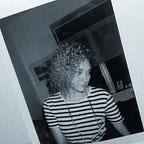Something I Never Talk About
How A Photo in a Book Saved My Life
It happened when I was a few months after I turned Twenty One. My grades steadily declining at college, I stopped writing, stopped enjoying anything, really. My hips and thighs were criss-crossed in self-inflicted slices. My hands were burnt by cigarettes and matches. I was taking a drug I had bought online, Phentermine, that I slept little on, and when combined with alcohol created erratic mood swings, manic energy switching in split seconds to vicious anger and crashing depression.
My daytime escape was found in bookshops and in hours spent reading.
One afternoon I picked up a copy of a book called Thin, filled with photos from the HBO documentary of the same name. In it, Lauren Greenfield shows in glaring honesty the realities of The Renfrew Center, a treatment facility for women with eating disorders. In this book there is one photo I couldn’t take my eyes off of. As I stared, I wished, “God, I want to look like her.”
The photo depicts a 25 year old woman, Shelly, admitted to the clinic weighing slightly over 84 pounds. She sits on a bed in a crop top showing her non-existant hips and flat, child-like belly. It took me well over a minute to register the feeding tube running directly into her stomach, attached to her skin with surgical tape.
To most people, it would be the very first thing they saw. To most people they would see a very sick, impossibly tiny, girl-woman. In this photo, I saw everything I wasn’t.
As I stood in that bookstore, tears began to burn my eyes. This was the first time I felt that I had something very wrong with me.
What started out my freshman year in college as controlled eating and eleven-mile runs and a weight of under 100 pounds, gradually morphed into my taking drugs typically prescribed to the morbidly obese and throwing up every time I ate anything.
At the time I saw the photo of Shelly in Thin, I was throwing up in excess of eight times every day.
For nearly three years my mind and body had succumbed to what was later diagnosed as EDNOS, Eating Disorder Not Otherwise Specified.
Fleeing to my car, I began to hiccup and sob. I fumbled with my phone, struggling to dial.
The silence after my mother picked up was deafening. I choked on another sob and managed to speak,
“Mom, I think I need help.”
